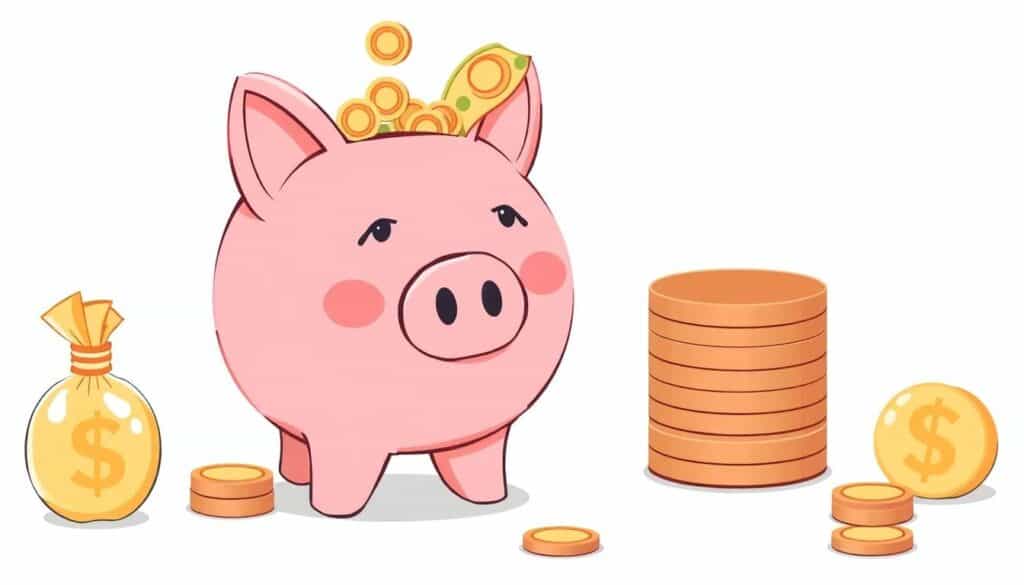Sometimes it feels like balancing self-care with financial responsibility is a juggling act that just never ends. But what if there was a simple way to enjoy both without feeling guilty?
That’s where a fun fund comes in. It’s not just another budgeting hack, it’s a way to reframe money as something that fuels your joy and balance.
Even if it’s that perfect latte at your favorite café or tickets to the concert you’ve been raving about, a fun fund is all about setting aside a little cash for the moments that make life sweet.
Through dedicating a special part of your budget just for fun, you’re not only taking care of your wallet but also giving your emotional well-being a boost.
It turns the idea of budgeting on its head, from a tale of deprivation to one of empowerment.
So, if you’re ready to feel more in control and less stressed, start small. Let your fun fund be the spark that shows taking care of yourself doesn’t have to be complicated.
Read on to discover 15 surprising secrets of fun fund that will show you how one joyful, guilt-free decision at a time can transform your life.
15 Surprising Secrets of Fun Fund
1. What Exactly Is a Fun Fund?
A “fun fund” might sound like another savings gimmick, but it’s so much more than that. It’s your permission slip to enjoy life without guilt while staying financially responsible.
This is like a mini-budget dedicated solely to the things that bring you joy. A little pot of money set aside to treat yourself, guilt-free.
Even if you want to splurge on weekend brunches or that hobby you’ve been meaning to pick up, it’s the key to balancing financial responsibility with self-care.
2. How to Create Your Fun Fund
Creating a fun fund is simple, and you don’t need to be a finance whiz to start. First, figure out what “fun” looks like to you.
Is it grabbing tickets for your favorite band’s concert, exploring a new hiking trail, or joining a pottery class? Once you know, set some rules to make it happen.
- Set an Amount: Start small. Maybe it’s $20 a week, or even $50 a month. Allocate what feels doable.
- Separate Your Fund: Keep it distinct from other savings and your main budget. Try a separate savings account or even an envelope in your drawer marked “fun fund.”
- Stick to the Rules: Use your fun fund only for its intended purpose, no timing your grocery runs here!
Relatable examples? Imagine saving $10 a week and, after a couple of months, having $80 to spend on something purely indulgent.
Maybe it’s that impromptu road trip you’ve been dreaming of. Treat yourself, you deserve it.
3. The Power of Fun Spending
Why does spending on yourself feel so good? Simple: it’s a form of self-care.
That coffee date with friends or the afternoon painting class? It’s not just spending money, it’s investing in your well-being.
When you reserve a part of your budget for fun, you’re actively encouraging a healthier mental state.
You see, much like a cheat day on a diet, positive spending habits prevent “money burnout.”
It’s easy to stick to a budget when it feels like it serves you and not the other way around.
- Reduce stress levels. A little treat here and there reminds you that money is a tool for living, not just for existing.
- Boost your mental health. Small joys, like trying a new restaurant, excite your brain’s reward systems.
- Build financial confidence. Knowing you can budget for fun makes sticking to your financial goals rewarding instead of restrictive.
Think of it this way: a fun fund is like recharging your emotional batteries. Life is unpredictable, and feeling a small sense of control over joyful experiences makes all the chaos more manageable.
Want to know the best part? It’s not about the amount, it’s about the impact. Even a simple movie night paid for by your fun fund can turn a rough week into one to remember.
So, what will your fun fund unlock for you? Let’s keep going, you’re closer than ever to finding that perfect rhythm between joy and responsibility.
4. Linking Financial Wellness and Emotional Health
Money and emotions are often intertwined, more closely than many of us realize.
When managed thoughtfully, your finances can support not just your daily needs but also your mental and emotional well-being.
A “fun fund” serves as a powerful reminder that nurturing both your wallet and your happiness doesn’t have to be an either-or decision.
5. The Emotional Boost of Guilt-Free Spending
We’ve all been there: you treat yourself to something indulgent, a guilt-laden latte or a spontaneous weekend getaway, and then immediately question if it was worth it.
Why does spending on joy feel so complex? That’s where intentional, guilt-free spending steps in.
Here’s the truth: setting aside money just for fun allows you to enjoy small moments without second-guessing. It’s financial freedom in bite-sized portions.
Think about it, when you allocate funds intentionally, even for indulgences, you’re not “going off track.” Instead, you’re sticking to a plan that includes room for joy. This helps replace financial stress with financial confidence.
Let’s take an example. Say you’ve put $25 a week into your fun fund. By the end of the month, you’ve got $100 to splurge on a special activity, a nice dinner, art supplies, or a massage.
Knowing this was intentional money prevents feelings of guilt and actually strengthens your relationship with money. It’s no longer the “enemy” holding you back; it becomes a supportive tool for happiness.
Does this make finances feel less like drudgery and more like a partnership? It should. After all, money is there to work for you, not the other way around.
For an extra boost, check out these 10 Simple Self-Care Practices that tie emotional health to daily well-being.
6. Preventing Burnout with a Budget for Joy
Constantly saving and avoiding “unnecessary” spending might seem like the smart thing to do, but it can create financial fatigue.
This like trying to run a marathon on empty. Without manageable ways to recharge, burnout is inevitable.
That’s where a dedicated fun fund brilliantly supports emotional health. Through having money earmarked for leisure, you avoid the burnout caused by endless budgeting or saving without breaks.
Just as we safeguard time for rest and hobbies, a fun fund ensures you’re financially prepared to enjoy those moments.
For instance, even something as small as buying a new book or trying a trendy café with friends can feel restorative.
These experiences don’t just charge your emotional batteries, they become a tangible reminder that money can enhance life without draining it.
If you’ve been feeling financially or emotionally stretched, consider how your financial habits align with your mental well-being.
Combining deliberate financial planning with mental health mindfulness benefits both aspects of your life.
Want to feel lighter in life and finance? Remind yourself to “budget joy” along with responsibilities. It’s a small step that makes a massive difference in how you approach money, and yes, in how you approach yourself.
Even if it’s preventing burnout or embracing small victories, the emotional payoff is priceless.
7. Step-by-Step: Launching Your Own Fun Fund
Starting a fun fund may sound like an indulgence, but it’s actually one of the smartest steps you can take for both your financial and emotional well-being.
Through carving out a dedicated space in your finances for joy, you’ll feel more balanced, less stressed, and totally empowered.
Let’s break down how you can get started, step by step.
Setting a Realistic Budget for Fun
The first step in creating your fun fund is figuring out how much you can comfortably set aside. This doesn’t mean cutting into your essentials, it’s about budgeting realistically.
Start by taking a good look at your income and fixed expenses. Then, ask yourself: how much do I want to dedicate specifically to joy?
A good rule of thumb is to allocate 5-10% of your income to discretionary spending, like your fun fund. For example, if you take home $3,000 a month, aim for $150–$300 in your fun fund.
Strapped for cash? Even $10 a week adds up quickly over time. The key is to choose an amount that fits your current lifestyle without creating financial strain.
Need help balancing your priorities? Read this article about how financial stress impacts your well-being and how to combat it.
8. Creative Strategies to Grow Your Fund
Once you’ve decided on a budget, it’s time to grow the fund in smart, simple ways.
Here are a few practical and fun strategies to build it up without feeling the pinch:
- Save Spare Change: Keep a jar at home, and toss in your pocket change every day. These small deposits might surprise you over time.
- Use Cashback Apps: Download apps like Rakuten or Honey, and stash the savings directly into your fun fund. It’s like getting free joy points every time you shop smart.
- Cut Tiny Expenses: Evaluate your current spending habits. Could you skip a takeout coffee once a week or cancel a rarely-used subscription? Redirect that cash into your fund instead.
- Round Up Your Purchases: Sign up for savings programs through your bank that “round up” debit card purchases and deposit the change into a savings account.
9. Tracking and Adjusting Your Fun Fund
As you dive into using your fun fund, it’s important to keep things on track. Start by monitoring how the money is spent.
app like Mint or YNAB can make this super easy, breaking down your spending habits so you know where your cash goes.
Still, life is unpredictable, sometimes you’ll need to tweak your fun fund to reflect changes in your budget or priorities.
Be flexible. If something pops up (like a big financial goal or emergency), it’s okay to temporarily lower your contributions.
On the flip side, a bonus or tax refund is a great opportunity to give your fun fund a boost.
Think of this as a financial check-in. Do you feel like you’re getting enough satisfaction from your fun spending? If the answer’s “yes,” great!
If not, it might be time to adjust the budget or explore new ways to enjoy yourself.
Starting your own fun fund is a simple yet life-changing step toward finding joy in your finances.
Allocating time and energy to actively nurture happiness is the key to feeling empowered in both your money and your life!
So, what small habit will you begin today to start building a fund for guilt-free joy? The choice is yours.
10. Making Financial Self-Care a Lifestyle
Making your finances work for you is about more than just paying bills and saving for the future. It’s about joy, balance, and giving yourself room to breathe.
Transforming financial self-care into a lifestyle means you’ll feel confident about where your money is going, every penny having a purpose, including the fun stuff.
Because who says practicality and playfulness can’t coexist?
11. Integrating Fun Spending with Big Goals
Balancing your fun fund with long-term financial goals doesn’t have to be tricky. Think of it like meal prep, you plan ahead to strike the perfect balance between splurging on dessert and getting your daily nutrients.
The same concept applies here.
Here are a few tips to help integrate your fun fund seamlessly:
- Set Clear Priorities: Start with the bigger picture. Are you saving for a dream vacation, retirement, or perhaps a down payment? Birthdays and dessert nights can coexist, it’s about planning.
- Allocate Percentages: Assign a certain percentage of your income to your fun fund (like 5-10%), while dedicating the rest to long-term savings, bills, and investments.
- Automate Savings: Make your fun fund automatic. Have a small amount deposited into a separate account every payday. That way, “fun” is always part of the plan, like sprinkles on top of everyday budgets.
- Set Realistic Limits: Track your spending in your fun fund to keep it guilt-free. For example, if your goal is to save for a big trip six months from now, curb fun expenses so they don’t shrink your vacation budget.
Balancing doesn’t mean depriving yourself. It’s about knowing what you value most and leaving room for spontaneity. And splurging on your favorite iced coffee every now and then is okay!
For more ideas on combining budgeting with happy spending, check out Empowerment on a Budget: The New Freedom.
12. Sharing the Joy
Sometimes, the best way to make your fun fund really count is to share its magic. After all, experiences often feel richer when they’re shared with loved ones.
Whether it’s treating your best friend to brunch, grabbing tickets to a show, or planning a cozy movie night, these shared moments foster deeper connections.
Why share your fun fund? Here’s why it works:
- Amplifies Happiness: Studies show that experiences, especially shared ones, bring more fulfillment than material things.
- Strengthens Relationships: Spending your fun fund on shared activities creates memories that last a lifetime.
- Guilt-Free Gifting: It’s thoughtful without feeling like a stretch, because it’s already budgeted.
Imagine using your fun fund to grab pizza with your family every other Friday or book a spontaneous weekend road trip with friends.
These aren’t just expenses, they’re investments in laughter, love, and the relationships that matter most.
Want more tips on weaving joy into your financial self-care routine? Dive into ways to reflect and cultivate self-love with ease.
Turning your simple, guilt-free spending into shared experiences can make your fun fund even more meaningful.
After all, spending money is about living, and what’s better than living in the company of those you cherish most?
13. Common Misconceptions About Fun Funds
When people hear “fun fund,” they often associate it with indulgence or irresponsibility. It’s easy to form the wrong impression, especially when money management is frequently tied to sacrifice and strict discipline.
But here’s the truth: a fun fund is not recklessly throwing cash at random pleasures. It’s intentional spending that adds joy to your life while aligning with your financial goals.
Through addressing common fears and myths about fun spending, this section aims to ease your concerns and show how a fun fund can actually work in your favor.
14. Debunking Myths About Fun Spending
Let’s clear up a few misconceptions that might make you hesitate about setting aside money for yourself. Spoiler alert: Responsible spending and indulgence can coexist!
- “It’s Selfish to Spend on Myself” Nope, not at all. Prioritizing your happiness doesn’t mean taking away from others. Think of it this way: if your car didn’t get regular tune-ups, it wouldn’t run smoothly. A fun fund is like giving yourself a mental tune-up, keeping you balanced and motivated.
- “Fun Spending Will Derail My Financial Goals” Absolutely not. Actually, integrating a fun fund into your budget can complement your goals rather than disrupt them. It adds flexibility and prevents burnout. Think of it as budgeting for joy, not chaos. If you’re juggling priorities, this guide on balancing financial goals can help you get started.
- “I Should Only Save for Big Purchases” While saving for large expenses is vital, ignoring the small joys could make your financial journey feel like drudgery. A new book, a yoga class, or even one delightful dinner can do wonders for your well-being without costing a fortune. Life’s too short not to enjoy the little things along the way.
- “Fun Spending Means Impulse Buying” Some think of fun spending as blowing cash without thought, but the opposite is true. A fun fund thrives on planning! The intention is to create space in your budget for thoughtful, guilt-free indulgences.
Still skeptical? Many of these pushbacks come from the belief that money is solely a tool for survival. While that’s part of its purpose, money can, and should also enhance your quality of life.
For an added perspective on reshaping money narratives, explore 18 Common Misconceptions About Money.
15. Overcoming the Fear of Spending on Joy
A lot of us have been conditioned to view spending on leisure as a weakness or waste.
It’s not. Breaking free from financial guilt is key to embracing healthier habits. After all, money is a resource, not a reward.
Here’s how to shift your perspective:
1. Ask Yourself: What Truly Brings Me Joy? Replace the mindset of sacrifice with one of intention. Does grabbing coffee with a friend lighten your week? Does trying a new hobby inject excitement into your life? Write down one or two manageable experiences that make you smile. These should be your fun fund’s focus.
2. Redefine “Guilt” Spending doesn’t have to be all-or-nothing. When you allocate money for joy, you’re working with your budget. It’s a plan, not a mistake! By using a fun fund intentionally, fears of overstepping vanish because the spending is pre-approved. Think of it as a partnership between fun and finance.
3. Start Small, Build Confidence Dip your toes in by setting aside a tiny amount, a few dollars a week. Once you see how manageable and fulfilling it is, those negative associations will start to fade.
4. Acknowledge Progress, Not Perfection Remember, the point is to infuse happiness into your finances, not stress about perfection. Life events will shift your financial landscape, and that’s okay. When you adjust responsibly, moving forward becomes part of the journey.
It’s time to silence that nagging inner voice saying no to the things you love. While caution is needed for major investments, don’t let fear hold your everyday joy hostage.
After all, happiness isn’t a luxury, it’s essential. For more tools to approach financial decision-making with clarity, check out this article about financial stress reduction.
Feel ready to approach spending with renewed confidence? With myths busted and guilt minimized, a fun fund feels a lot less like a splurge and more like an empowering life tool, doesn’t it?
Final Thoughts
A fun fund is not just spending, it’s caring for yourself in a way that feels balanced and empowering.
When you dedicate a little space in your budget for joy, you’re choosing financial wellness combined with emotional freedom.
It’s simple and effective. Your fun fund helps reduce stress, boost happiness, and build a healthy money mindset.
Even if it’s a small weekend treat or a big-ticket splurge, intentional spending lets you experience more of life without guilt.
Here’s your friendly nudge: why not start today? Take five minutes, set a goal, and commit to nurturing both your wallet and your well-being.
Want more ideas on practicing financial self-care? Explore simple journaling techniques to feel more balanced every day.
Learn more about balancing financial priorities while practicing self-care here.
To learn more, check out why having a fun fund is transformative for your financial mindset. Learn more about mental and financial health connections here.
Love what you see? Share the love with friends and pin it to your Pinterest.
Every share and pin means the world to us, helping us inspire more people. Subscribe and share.
Sharing is caring.







